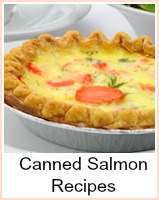


The possibilities are endless, so get creative! Looking for an easy appetizer? Try it in our salmon patties, croquettes, or meatballs, or as a dip, like in our smoked salmon dip. Want something heartier? Turn it into a burger, like our lemon-dill salmon burgers or Greek salmon burgers, or stir it into some pasta for added protein, like in our smoked salmon pasta or our lemon butter salmon pasta. Not into mayo? Skip it, and put your canned tuna atop a rice bowl (or inside rice, like in onigiri!) or salad, like our Niçoise salad or salmon BLT salad. Treat it like tuna, and make a tuna salad with salmon (or add cheese, à la a tuna melt?). You can pretty much use canned salmon anywhere you’d use cooked salmon, though admittedly it works better in recipes where the salmon is flaked rather than enjoyed whole. It’s really up to your preferences which you prefer, so give them a try in these recipes to figure out your favorites. You’ll also encounter a variety of terms, like pink versus sockeye, skinless and boneless versus not, packed in water or oil, smoked, etc. Key ingredients Fish - we use kokanee, but salmon or trout works well too. Try combining it with a little pasta or couscous for a nutrient-dense meal. You can make amazing quick recipes with canned mackerel. The fat content is also very low, only containing around 1 gram of saturated fats. We think it’s worth the added price (considering how much you’re saving from not buying fresh!), but it’s something to keep in mind when you’re shopping. Canned mackerel contains around 120 calories and a whopping 17 grams of protein. Wild salmon has a better overall rating (no antibiotics added to their feed, more environmentally sustainable, less mercury etc.), but it can be more expensive. Most canned salmon consists of two types: farmed (usually Atlantic salmon) or wild salmon (Wild Alaskan is the best). While canned salmon is inarguably more convenient and affordable than its fresh counterpart, there are still some things to look out for. Check out our top 15 canned salmon recipes for ideas-we bet you’ll pick up a can or two on your next grocery trip. In 2015, the environmental watchdog Greenpeace released a buyers guide for canned tuna. You can use it like you would canned tuna: in healthy dinner salads, weeknight pasta dinners, as a burger base, or as a substitute for raw fish in sushi bowls. Tuna is perhaps one of the stickiest wickets when it comes to the canned seafood conundrum. These recipes are WAY easier than cooking a salmon filet-and much cheaper to shop for. Watch for sodium: If you're on a low-sodium diet or just looking to reduce your salt intake, check your food labels to find the brand with the lowest amount of sodium.If you haven't experimented with canned salmon yet, your world is about to be rocked. Look for a minimal ingredient list: You can buy canned fish with seasonings or flavors, so always check the ingredient list to ensure you're OK with all of the added flavors.The good news is that all of these bones are edible and a wonderful source of calcium. Some sardines have the bones removed, and much of the canned salmon you buy will also have bones. Anchovies often come with bones, but they are not even noticeable. Check for bones: If having the bones in your fish is a no-go, then you might want to choose a different kind.For those allergic to soy, check the label to make sure soy isn't an added ingredient.

Mind the type of oil: If your fish is packed in oil, make sure you're choosing an oil you are comfortable with, such as olive oil. Choose BPA-free cans: Most cans now are BPA-free, but it's good to double-check by looking for a BPA-free label.


 0 kommentar(er)
0 kommentar(er)
